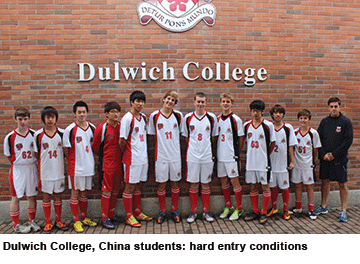 In 1979, when Ken Ross was eight, his family moved from Scotland to France with his father’s job in IBM. The computer firm paid the fees at the English School of Paris, where his classmates were mostly children of expats from Britain and elsewhere: managers, army officers, diplomats and the like. A couple were Saudi princes. For the most recent class reunion, old boys and girls flew in from as far afield as China and South Africa.
In 1979, when Ken Ross was eight, his family moved from Scotland to France with his father’s job in IBM. The computer firm paid the fees at the English School of Paris, where his classmates were mostly children of expats from Britain and elsewhere: managers, army officers, diplomats and the like. A couple were Saudi princes. For the most recent class reunion, old boys and girls flew in from as far afield as China and South Africa.
Since then, there has been a boom in such ‘international schools’, which teach in English in non-Anglophone countries, mostly offering British A-levels, American APs and SATs, or the International Baccalaureate. During the past quarter-century, according to the International School Consultancy Group (ISC), based in Britain, their number has grown from under 1,000 to more than 7,300.
In the 2013-14 academic year, they generated $41.6 billion (Rs.2.6 lakh crore) in revenue and taught 3.75 million pupils globally.
Twenty-two countries have more than 100 international schools, headed by the UAE, with 478, and China, with 445.
But nowadays international schools increasingly belie their name. Though their clientele varies from place to place, four-fifths of pupils they teach around the world are locals, calculates ISC. Thirty years ago, just a fifth were. The main reason is increased demand for schooling mostly or entirely in English, both in rich countries (Ross’ alma mater now has a large French contingent), and even more from rich parents in developing countries who want their children to be able to go to university in Britain or North America. “When people make money, they want their children to learn English,” says Nicholas Brummitt of the ISC. “When they make more money, they want them to learn in English.”
Further growth is on the cards. In another decade, ISC predicts, there will be 14,400 international schools worldwide, teaching 8.9 million pupils. Many will be run by local or regional firms who spy an opportunity (two-thirds of international schools are now run for profit, up from almost none 30 years ago). But ISC’s market research suggests that quite a few British ‘public’ (i.e, private) schools plan to set up foreign outposts; some already have, including Harrow, Marlborough, Wellington College and Dulwich College, the last of which opened its seventh overseas arm in Singapore in August. For-profit global chains such as Nord Anglia Education, Cognita and GEMS are also planning new schools.
The biggest growth is forecast in the Middle East and East Asia. But which countries prove the most rewarding for investors depends partly on governments. Some countries make it hard for those who have been schooled outside the national system to get into university, meaning international school customers risk closing off their children’s future options. Chinese pupils without a foreign passport are barred from international schools. Singaporean citizens require government permission to attend international schools, rarely granted unless they have lived abroad. In South Korea, a maximum of 30 percent of an international school’s pupils can be locals.
China-watchers are always alert to any hint of liberalisation. The country has 2.5 million dollar millionaires, many of whom would pounce at international schooling for their offspring if they were allowed to. Since 2001, foreign groups and individuals have been allowed to own schools in partnership with Chinese citizens, and since 2003 schools can be run for-profit — but only authorised international schools can follow a foreign curriculum. The government fears losing control over what children are taught. Officials also argue that without strict rules Chinese parents could be gulled by greedy foreigners.